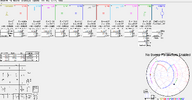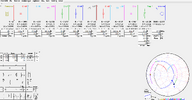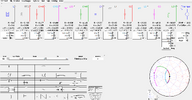Power mods affect the transistors output impedance, and changing the DK will de-tune everything after it. For this example, I assumed the transistor had a 5Ω output impedance with factory settings and adjusted the coils to match based on the capacitor values given. That coil (L38) that once matched the 5Ω transistor impedance to the 50Ω filter network, will no longer match to 50Ω. Turning up the dead key may not release the magic smoke, but that is one thing that can knock down the sharpness of the L-match adjustment, because instead of passing through 50Ω, the path change caused by that adjustment is now further away from the center and not crossing it, but instead, more closely following a constant SWR path. Here is everything tuned for a 5Ω transistor impedance. The blue line is the effect of varying L38 from 180nH to 210nH.

But lets say we mess with the output power (thus transistor impedance)? These next two are the effects of the same L38 adjustment with a 3Ω transistor and a 7Ω transistor:

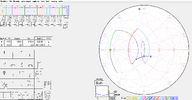
Notice how that adjustment now causes the adjustment to ride along the 2:1 SWR circle? This translates into less change in output power for a given tuning range.
Up to this point, I have excluded the harmonic trap because I have an issue with it ~ recall that I used the capacitor values from the schematic. For this part, I am back to the 5Ω transistor impedance and this time the blue line is sweeping the frequency response. Adding the harmonic trap de-tunes the network such that adjusting any of the inductors will not provide a match. Here is without the trap (horizontal blue line sweeping network response from 26-28MHz):
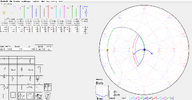
But if I then add the trap, this happens:
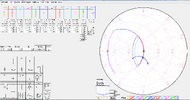
Still within the 2:1 SWR circle, but again, this affects the response of the adjustments. As the big guy says, C'mon Man! And it seems the only way to correct that on the smith chart is to change the value of C141 from 82pF to 47pF. I have not tried this in practice, but I might as my current 148/stalker project has similarly insensitive adjustments on the back end.
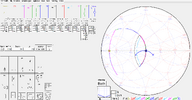
Is it worth chasing absolute perfection making these adjustments do exactly as they were intended, probably not.. But I find this stuff interesting and felt it was worth at least sharing.







